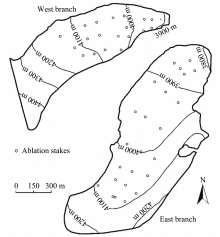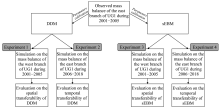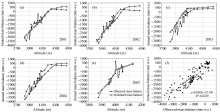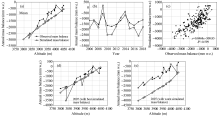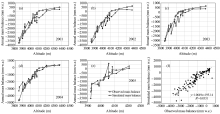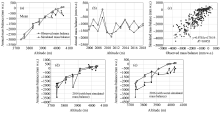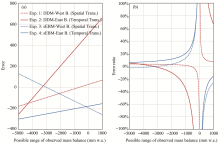Sciences in Cold and Arid Regions ›› 2020, Vol. 12 ›› Issue (2): 95–103.doi: 10.3724/SP.J.1226.2020.00095.
Spatial and temporal transferability of Degree-Day Model and Simplified Energy Balance Model: a case study
- 1.State Key Laboratory of Cryospheric Science, Northwest Institute of Eco-Environment and Resources, Chinese Academy of Sciences, Lanzhou, Gansu 730000, China
2.Tianshan Glaciological Station, Chinese Academy of Sciences, Lanzhou, Gansu 730000, China
|
Aðalgeirsdóttir G, Jóhannesson T, Björnsson H, et al., 2006. Response of Hofsjökull and southern Vatnajökull, Iceland, to climate change. Journal of Geophysical Research, 111(F3: F03001. DOI: 10.1029/2005jf000388.
doi: 10.1029/2005jf000388 |
|
|
Azam MF, Wagnon P, Vincent C, et al., 2014. Processes governing the mass balance of Chhota Shigri Glacier (western Himalaya, India) assessed by point-scale surface energy balance measurements. Cryosphere, 8(6): 2195-2217. DOI: 10.5194/tc-8-2195-2014.
doi: 10.5194/tc-8-2195-2014 |
|
| Braithwaite R, 1984. Calculation of degree-days for glacier-climate research. Zeitschrift Fur Gletscherkunde Und Glazialgeologie, 20: 1-8. | |
| Braithwaite R, Olesen O, 1989. Calculation of glacier ablation from air temperature, West Greenland. In: Oerlemans J, editor. Glacier Fluctuations and Climatic Change Dordrecht: Kluwer Academic Publishers. Dordrecht: Kluwer Academic Publishers, pp. 219-233. | |
|
Braithwaite RJ, Zhang Y, 2000. Sensitivity of mass balance of five Swiss glaciers to temperature changes assessed by tuning a degree-day model. Journal of Glaciology, 46(152): 7-14. DOI: https://doi.org/10.3189/172756500781833511.
doi: 10.3189/172756500781833511 |
|
| Gao H, He X, Ye B, et al., 2011. The simulation of HBV Hydrology Model in the Dongkemadi River Basin, Headwater of the Yangtze River. Journal of Glaciology and Geocryology, 33(1): 171-181. (in Chinese) | |
| Gao X, Zhang SQ, Ye BS, et al., 2010. Glacier runoff change in the upper stream of Yarkant River and its impact on river runoff during 1961-2006. Journal of Glaciology and Geocryology, 32(3): 445-453. (in Chinese) | |
|
Giesen RH, Andreassen LM, Oerlemans J, et al., 2014. Surface energy balance in the ablation zone of Langfjordjøkelen, an arctic, maritime glacier in northern Norway. Journal of Glaciology, 60(219): 57-70. DOI: 10.3189/2014JoG13J063.
doi: 10.3189/2014JoG13J063 |
|
|
Giesen RH, Oerlemans J, 2012. Calibration of a surface mass balance model for global-scale applications. The Cryosphere, 6(6): 1463-1481. DOI: 10.5194/tc-6-1463-2012.
doi: 10.5194/tc-6-1463-2012 |
|
|
Huss M, Hock R, 2018. Global-scale hydrological response to future glacier mass loss. Nature Climate Change, 8: 135-140. DOI: 10.1038/s41558-017-0049-x.
doi: 10.1038/s41558-017-0049-x |
|
|
Johannesson T, 1995. Degree-day glacier mass-balance modelling with applications to glaciers in Iceland, Norway and Greenland. Journal of Glaciology, 41: 345-358. DOI: https://doi.org/10.3189/S0022143000016221.
doi: 10.3189/S0022143000016221 |
|
| Li W, Li Z, Li H, 2017. Analyses on transferability of Degree-Day Model and simple Energy Balance Model — in case of Urumqi Glacier No. 1. Journal of Anhui Agricultural Sciences, 45(2): 47-52. (in Chinese) | |
|
MacDougall AH, Wheler BA, Flowers GE, 2011. A preliminary assessment of glacier melt-model parameter sensitivity and transferability in a dry subarctic environment. The Cryosphere, 5(4): 1011-1028. DOI: 10.5194/tc-5-1011-2011.
doi: 10.5194/tc-5-1011-2011 |
|
| Oerlemans J, 2010. The Microclimate of Valley Glaciers. Igitur, Utrecht Publishing & Archiving Services, Utrecht, pp. 1-138. | |
| Wang D, Zhang P, 1985. On the valley climate of Urumqi River in the Tianshan Mountains. Journal of Glaciology and Geocryology, 7(3): 239-248. (in Chinese) | |
| Xie Z, 2010. Introduction to Glaciology. Shanghai: Shanghai Popular Science Press, pp. 1-490. (in Chinese) |
| No related articles found! |
|
||


